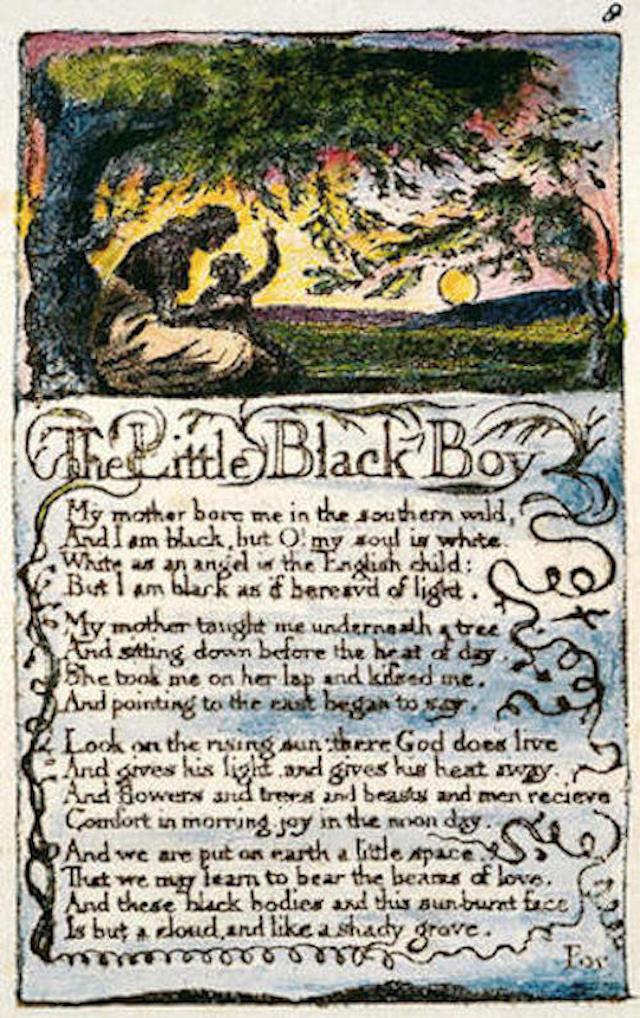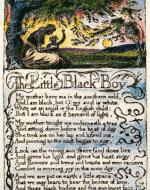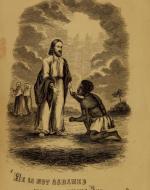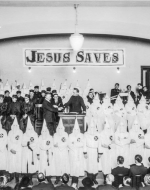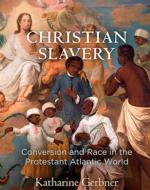Created by Montse Magallon on Sun, 04/10/2022 - 22:25
Description:
Introduction
“Thus did my mother say and kissed me, / And thus I say to little English boy. / When I from black and he from white cloud free, / And round the tent of God like lambs we joy.”
At first glance, “Little Black Boy” written by William Blake may seem like a poem about a little African boy’s journey with Christianity, but is it just that? Over time there have been many written pieces that are aimed to crush racism but instead have the opposite effect. A common pattern is the use of an omnipotent and omniscient God that reinforces racial injustice. It isn’t including a God that does this, but rather how he is written and how these ideas are used that does. In this poem, the African boy points out the color of his skin as well as the English Boy’s. He specifically connects his black skin to dark symbols that are known to be negative, such as dark clouds. In contrast, he connects the English boy’s whiteness to pure and good attributes, such as angels. In the end, he essentially disregards every hardship by saying that God’s love will make it all okay. “And be like him and he will then love me” (Blake). Additionally, this line from the poem reinforces that idea that the little African boy will only be loved by God if he is white like him.
For a long time, people have used Christianity as an excuse for slavery and to justify it. Lauren Henry from Blake Archive explains that people should “consider that Christian doctrine was deployed both by pro-slavery apologists who argued that African servitude was ordained by God, and by abolitionists who asserted that the institution of slavery was incompatible with Christian teachings.” So, while these people are trying to use Christianity as an excuse, what they don’t realize is that these teachings and ideas have been enforced by individuals who have always supported slavery. This, among plenty of other reasons, is important to keep in mind when religious approaches are taken by white authors in an effort to crush racism and write an abolitionist piece.
Through a variety of different images, this exhibit will showcase examples of religion and God being used to reinforce social injustices, slavery, and racism.
Works Cited
Blake, William. “The Little Black Boy.” https://studio.covecollective.org/anthologies/sp22-eng-l302-anthology/do...
Henry, Lauren. “Volume 29 · Issue 1.” Blake/An Illustrated Quarterly, https://bq.blakearchive.org/29.1.henry.
Images in the Series:
Fig. 1. Bentley, Erdman, Keynes. “The Little Black Boy.” 1789. The William Blake Archive, http://www.blakearchive.org/copy/songsie.l?descId=songsie.l.illbk.08.
The image above shows the little Black boy sitting underneath a tree with his mother as they talk about God. There are many important details in this image that are used to portray the message of the poem. The sun, which is used as a symbol for God, can be seen in the background of this image, almost as if watching over them. This visual is a close representation of the following line: “Look on the rising sun! there God does live” (Blake). A message in this poem is the idea that African people are meant to shade the White people until they are ready for God’s love, and this can be seen as the little boy is pointing up at the tree. In the image, the little boy and his mother’s body language portray them to be happy, as if God’s love makes everything okay. They appear to be having a conversation like any other. This is sending the wrong message to people and disregards everything that African slaves had to go through. Upon reading the poem and seeing the visuals, it can be easy to see it as a proper effort of an abolitionist piece but, it is very tone-deaf. This image ignores the social injustices and cruelties that African slaves endured and instead attempts to solve it simply by making the focus, God’s love, rather than talking about the reality of things.
Fig. 2. Jewett, John P. “Autographs for Freedom.” 1853. Public Domain Review, https://publicdomainreview.org/collection/autographs-for-freedom-1853.
There were a lot of African slaves who were forced into Christianity. Many slaveholders forced religion onto them and even used it as a form of control. Many slaves who were forced into this religion had completely different views, while others who were willingly Christian, would get beaten for it. The caption on this image, “He is not ashamed to call them Brethren” brings up the idea that God is not ashamed of African slaves. This is problematic because it is instilling the idea that God’s love is beyond everything else, and while there is nothing wrong with having religious beliefs, there is something wrong when these beliefs are used as an excuse and justification for cruelty. Additionally, it creates a false narrative that God made these things happen for a reason and that it is normal for things to be this way. To add onto this, in “Little Black Boy” Blake wrote that, “And we are put on earth a little space.. / That we may learn to bear the beams of love” which is stating that no matter what happens, they should be loving of one another. This can be seen above as the African man is holding God’s hand despite everything that he has been through. It can be easy to say that love, specifically God’s love fixes everything but that isn’t the reality. The reader must also keep in mind that the poem was written by a white man who never had to experience oppression.
Fig. 3. Oregon Historical Society. “Meeting of the KKK,” 1920s. The Salt Late Tribune, https://www.sltrib.com/news/nation-world/2018/04/10/revisiting-the-preac....
Using religion, more specifically Christianity, to justify any sort of cruelty has been a common pattern all throughout history. It is used in worse ways than others at times and white supremacists use the bible to defend their actions. One of the many passages that has been used is Ephesians 6:5 which says that “Slaves, obey your earthly masters with respect and fear, and with sincerity of heart, just as you would obey Christ.” The image above shows the reality of how things were and how religion was used by white supremacists. Behind them there is a sign that says “Jesus Saves” which again shows the idea that to them their actions were correct because of their religion, and they didn’t think they were doing any harm. This is an example of the root of the problem. Since these white men instilled these ideas that they were superior and used violence, more people would then use the bible to excuse their actions. Additionally, this image can be a visual for the idea in “Little Black Boy,” that it’s okay if you’re black because once you die, “The cloud will vanish” and God will love you because you are white. So, essentially, until you die and “become white”, you are a shadow and are not as important.
Fig. 4. Gerbner, Katharine. “Christian Slavery.” 2018. Ben Franklins World, https://www.upenn.edu/pennpress/book/15798.html.
Slaveowners created certain codes and rules all revolving around religion. They made many attempts to convert slaves to Christianity despite their own individual beliefs. Their ideas about slavery were largely influenced, if not reinforced by Christianity. In the image above, African people are seen among White people who are representing Christians. This image is depicting the idea that with religion, everyone can easily get along and be peaceful, which is not correct. The fact of the matter is, that no matter how Christian a Black person was, they would continue to get mistreated. Forcing religion onto them was just another form of control and another way for slaveholders to threaten them. So, while “Little Black Boy” by William Blake described a world where God’s love and religion made everything okay, that just isn’t the reality of it all. Everyone has different religions and different beliefs. Additionally, those that believe God’s love conquers all, may not realize that it takes a lot more to make a change.

